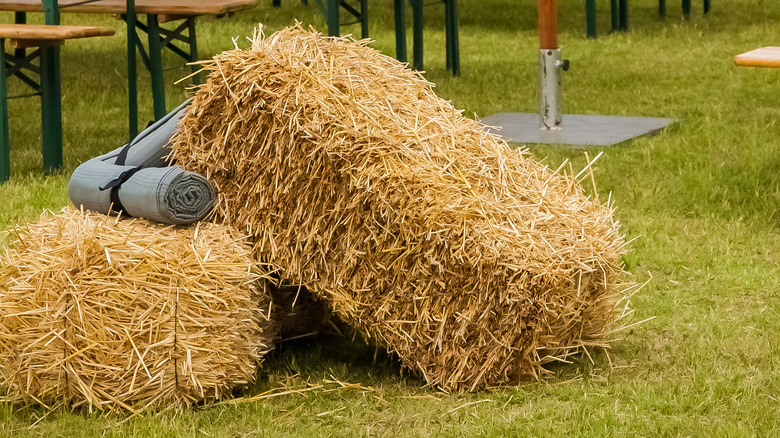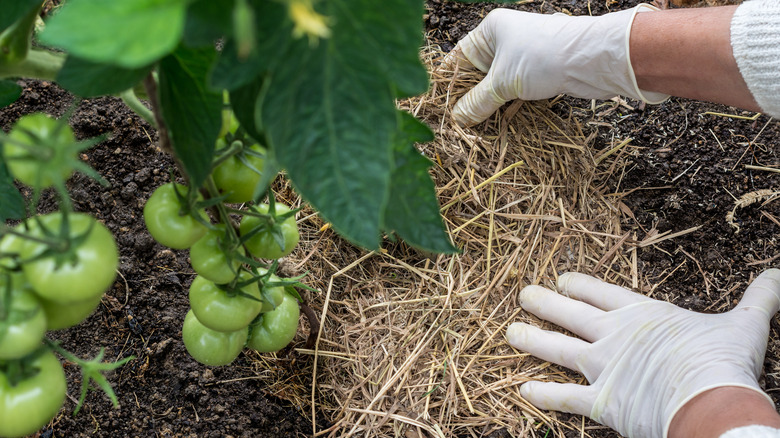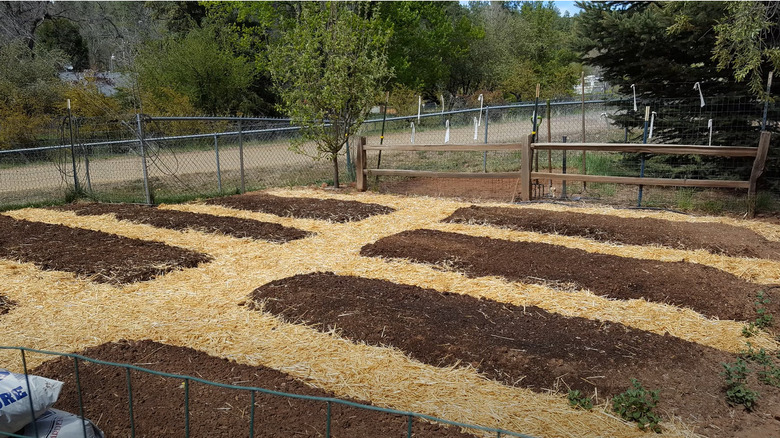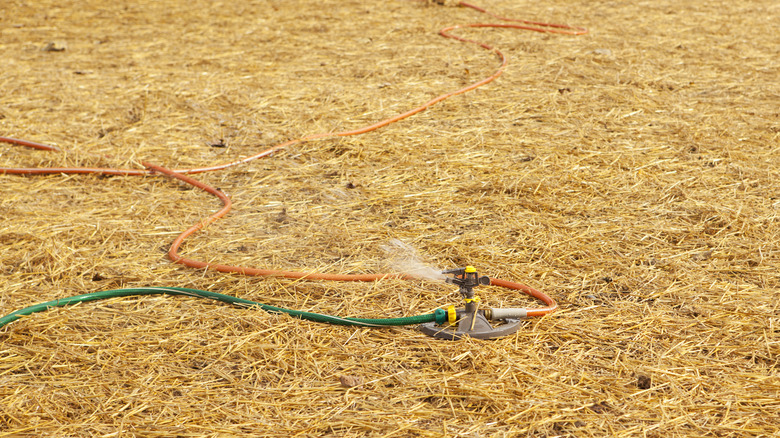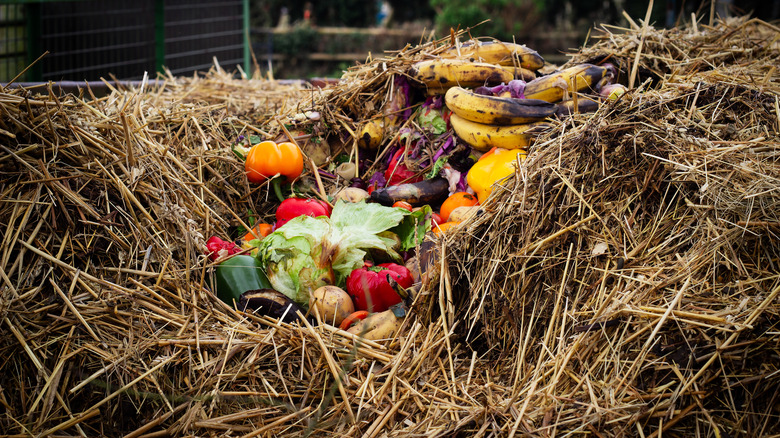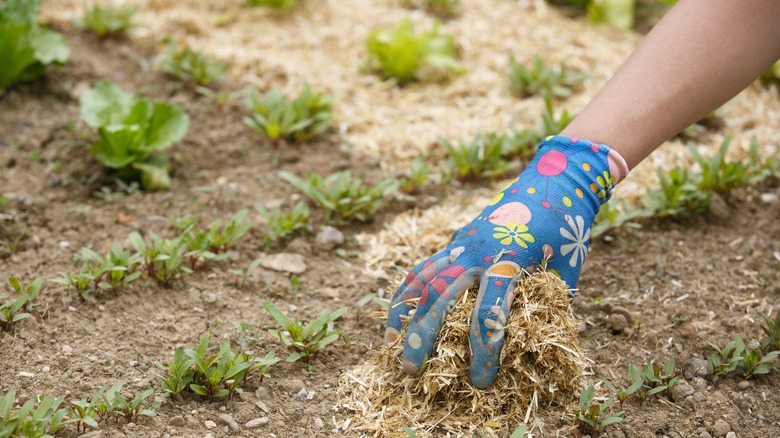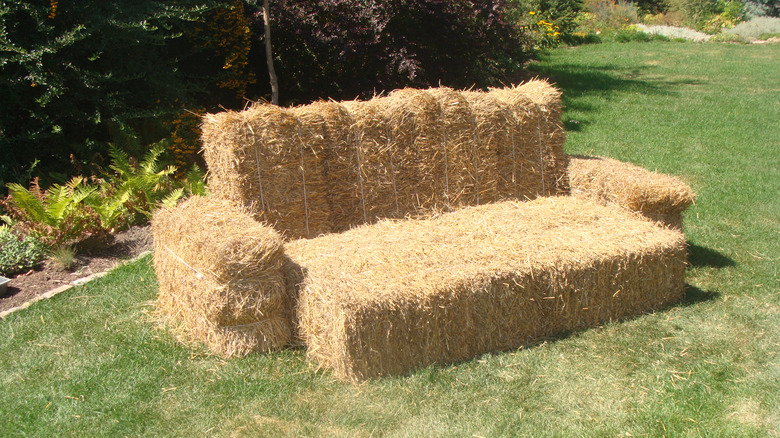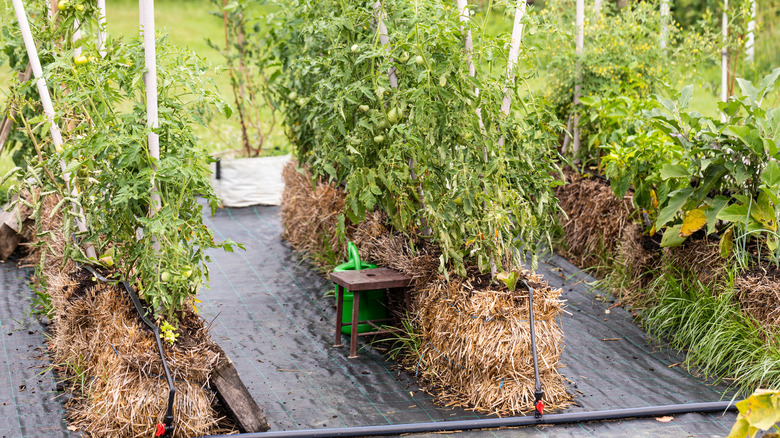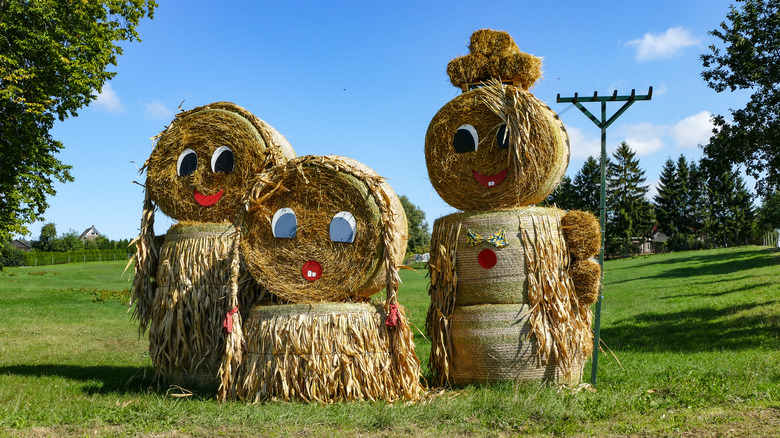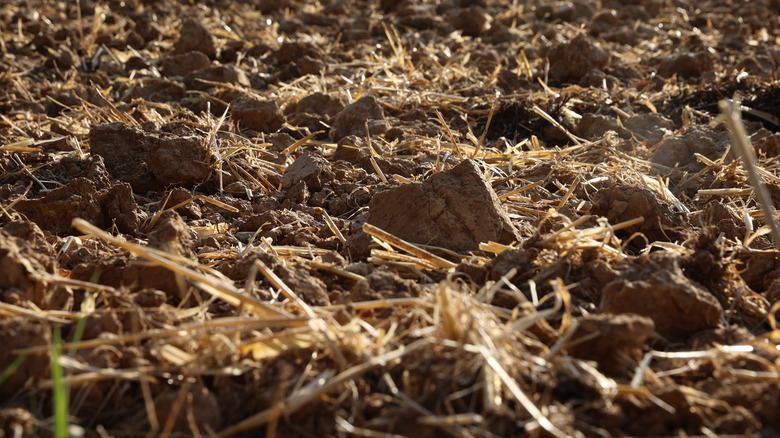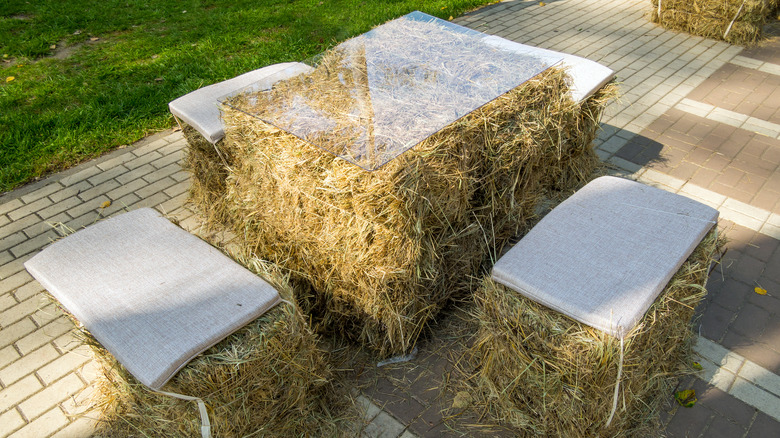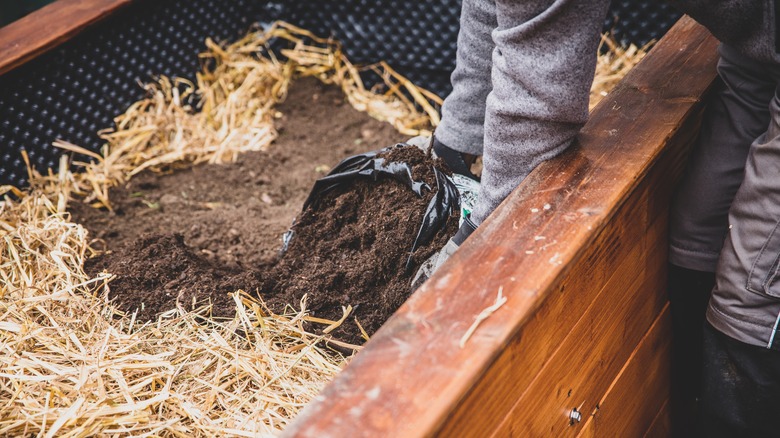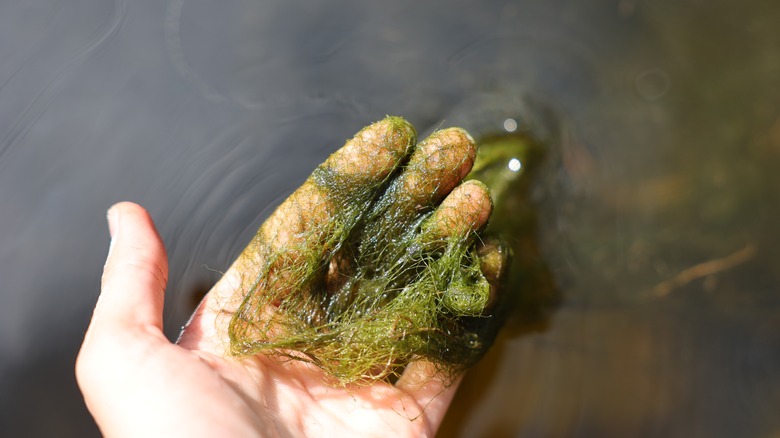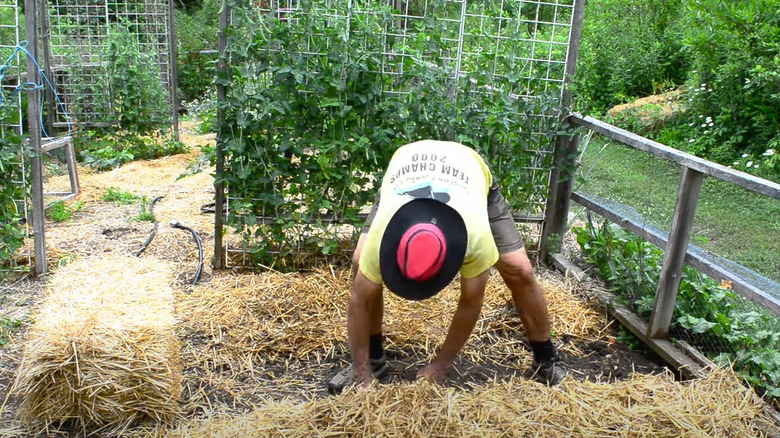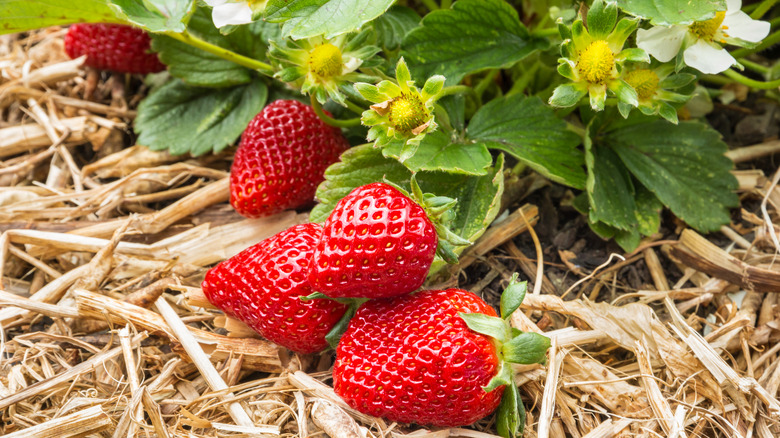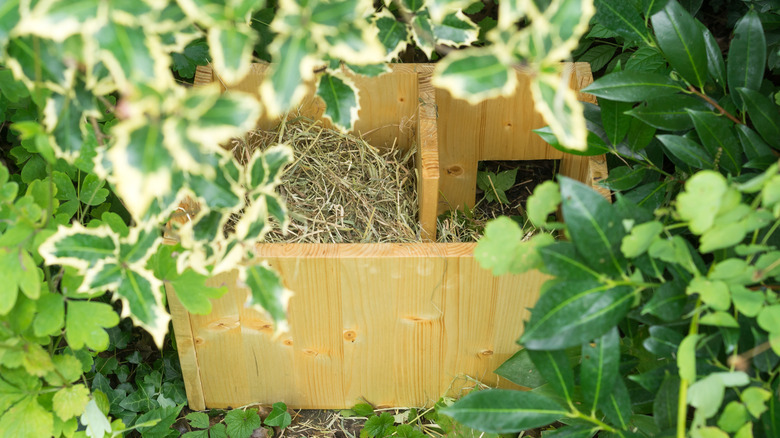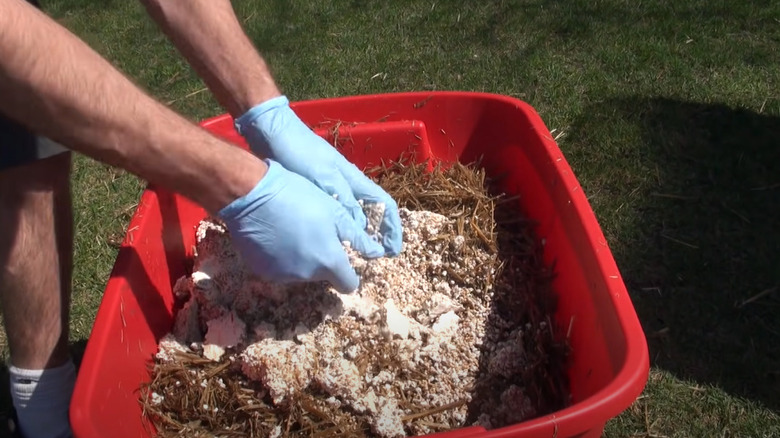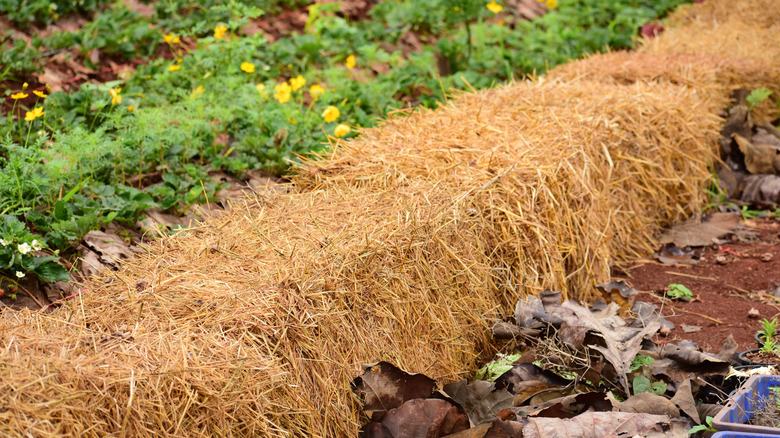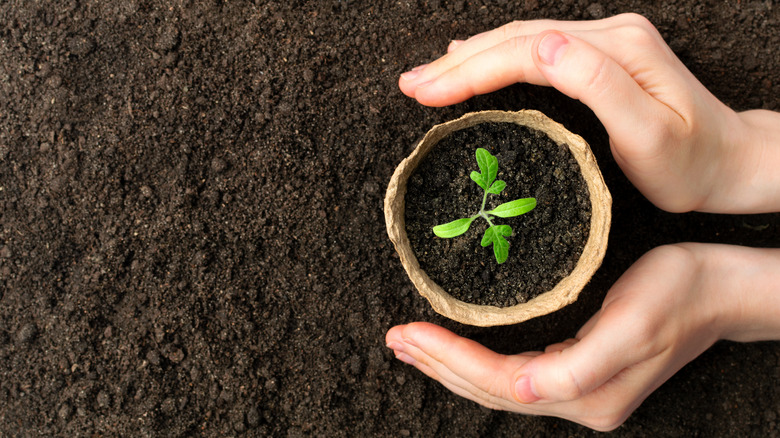19 Ways You Should Be Using Straw In Your Yard And Garden
Nestled inconspicuously in storage sheds or perhaps overlooked in the corner of your farm store lies a gardening powerhouse item just waiting to be unleashed into your yard and garden: straw. This item is made up of the dry stalks leftover from grains like wheat, barley, rice, and oats — though the course corn resists this transformation. To differentiate straw from hay, know that the latter is comprised of dried grass or legumes. Straw not only wards off pesky weeds but also conserves moisture, guards against splash and surface erosion, and prepares a fertile ground for your next harvest. Oh, and have you heard of straw bale gardening? As you can see, there are so many uses for this material, and we've listed 19 of them below.
However, whether the straw is from your own barn or procured from a local farmer or garden center, be watchful for weed seeds hidden within, lest you unleash an army of unwanted plants in your green patch. Further, straw mulch won't kill every existing weed. Additionally, the lightweight nature of straw means that it can be whisked away by the wind. Fortunately, this concern is easily mitigated by a blessing from Mother Nature's sprinkler system (in other words, rain). However, if the skies stay clear, simply submerge the straw in a trough or large container with water before deployment. If that's not feasible, drench it using a garden hose or sprinkler post-application, transforming it into a steadfast shield for your soil.
1. Mulch around plants
Envision a lush garden where each plant thrives in a perfectly-balanced miniature ecosystem, all thanks to straw mulch. Watch as this simple item works wonders by conserving the moisture level, banishing those pesky weeds, and contributing a feast of nutrients to the soil when it breaks down. Take care to leave a little breathing room around the stems, avoiding a too-snug fit that might cause moisture buildup and invite unwelcome fungi to the party. Also ensure you avoid this straw mulch mistake: Don't underestimate the persistent nature of perennial weeds, as they can push through the straw, begging the need to tend to them first.
2. Place down mulch for garden pathways
Transforming your garden paths into inviting, natural-looking trails is easier and more sustainable than you think. By shaping garden paths with compacted straw, you create a soft, mud-free surface that enhances the rustic charm of your outdoor space. Start by defining your pathways, then possibly lay a foundation of gravel or pieces of cardboard before topping it with a generous layer of compacted straw. This not only offers a pleasing, cushioned walkway but also a biodegradable one that you can easily refresh or change. Adding border materials like stones or logs can enhance the aesthetics and keep the straw contained, blending functionality with beauty.
3. Assist seedlings
Freshly-planted peas, beans, and grass seeds are akin to treasures that invite unwanted attention from aerial thieves. A strategic deployment of straw can safeguard your precious seeds from becoming a feast for birds. Scatter a straw covering over the area, keeping in mind that a too-thick layer might smother your fragile seeds. While light, this layer is robust enough to ensure vulnerable seeds remain undisturbed on their journey to the surface. However, as soon as the seedlings peek through the earth, this straw shield must be gently lifted off the new growths. This protection method extends to seed nurseries (think cabbages) as well.
4. Add brown material to your compost pile
Now, let's dive into the heart of your garden's renewable resource: compost. Think of straw as the secret ingredient in your DIY compost recipe, balancing the greens and browns to create the perfect blend of nutrients. By introducing straw, you add carbon to the mix, guaranteeing your mature compost is a fertile haven. Layer it up; straw, green scraps, and repeat. With each addition, you're crafting a nutrient-rich compost that plants would line up for in the botanical world. Keep the mix aerated and hydrated and watch as the straw magically assists in breaking down waste into black gold.
5. Blanket plants during winter
When winter whispers its chilly secrets, it might be time to tuck your garden into a bed of straw. Straw acts like an insulating blanket, locking in heat and nurturing a more stable, cozy soil temperature for your plant's roots. Embark on this endeavor in late fall upon the arrival of frost, diligently piling straw around the bases of plants or spreading it across garden beds. Wheat or rye straw will typically compress to approximately half the initial thickness. As winter loosens its grip with the onset of spring, gradually remove the straw to allow the earth to awaken naturally.
6. Build an organic sofa
This inventive concept elegantly marries functionality with rustic charm, turning everyday straw bales into the foundation of a unique outdoor seating arrangement. Start with as many straw bales as needed, considering the size and design of your outdoor furniture. Arrange them into a shape that sings out 'sofa' — maybe build a typical bench seat sofa for simplicity, or perhaps venture towards a sectional for additional seating, ensuring these foundations are firmly-stacked. However, the straw bales are not the epitome of comfort yet. Adorn the surface of your straw bale bones with a generous layer of soft cushions dressed up with weather-resistant fabric.
7. Grow vegetables in bales
This hack sees entire bales turn into thriving garden beds. Straw bale gardening for vegetables eliminates the need for traditional soil beds, bypassing the usual battles with soil-borne pests and diseases while offering improved drainage and aeration. Before the magic unfolds, ensure that your bales are free from herbicides and weed seeds. Then, align them in rows (or use them to define your patch's perimeter). Next, conditioning takes center stage, where you introduce a high-quality potting mix and a well-balanced NPK fertilizer, evolving the bales into a prime, nutrient-packed habitat. The grand finale involves transporting your vegetable seedlings into the tops of these conditioned bales.
8. Decorate with outdoor figures
Unleash your creativity with outdoor figures crafted from straw bales. Kick off the endeavor by placing two large, circular bales face to face, forming a robust, cylindrical body. To breathe life into them, a singular circular bale, acting as the head, is perched with deliberate care to one side. Shorter figures could use a single circular bale for their bodies for a charming contrast to their taller counterparts. Large googly eyes and plastic lower lips grant expressive faces to these straw beings, sides adorned with dried maize plants weave in a touch of the harvest season, and cuboidal bales carefully-placed atop the heads mimic hat crowns.
9. Condition the soil
Compacted soil can stifle root growth and water penetration. Luckily, the solution might be as straightforward as incorporating straw into your garden's regimen. Straw can be spread over and lightly-tilled into dense soil, introducing vital air spaces and encouraging beneficial soil organisms that support healthier plant growth. Start in small sections to gauge the improvement, ensuring the straw is mixed well with the soil to prevent matting and optimize decomposition. Beware of the balance; an overabundance of straw can temporarily lock away nitrogen. Thus, thoughtful integration, including adding compost or a dash of organic fertilizer before applying mulch, charts a course toward long-term soil richness.
10. Craft backyard benches and a table
Inject a rustic twist into your backyard get-together with this ingenious idea: Craft benches and a table from nothing more than straw bales. Start by assembling your bales in a formation best suited to your space, perhaps a semi-circle for an intimate gathering. With each bale acting as a seat, introduce a layer of comfort using cushions or blankets. Now, for the pièce de résistance: the table. Group a few more bales in the center, securing them together tightly with sturdy sisal or cotton twine. This forms a firm base that you can finally crown with a slab of glass or wood.
11. Use straw as a foundation for raised beds
How about harnessing the simplicity of straw to foster your raised plant beds? Begin by framing your gardening space with wooden blocks to outline the desired perimeter of each raised bed. Within this natural enclosure, layer straw, which you can top off with compost-enriched soil for a fertile haven for seeds and plants. Not just a foundational sponge that holds moisture for your beds, the straw beneath becomes a living component of the garden's ecosystem. Gradually decomposing, the straw enriches the overlying soil with essential nutrients and fosters an aerated structure that's beneficial for root growth and microorganism activity.
12. Provide birds with nesting material
Fancy having a more twittery, fluttery garden? Help our feathery friends create cozy homes amongst your lush greenery with some straw. Strategically place handfuls of straw within easy reach on tree branches, within shrubbery, or near bird feeders, ensuring they won't blow away. This creates a natural invitation for freeloading fowls to construct their nests using the provided straw material. Having birds take up residence offers added bonuses: their merry songs are charming (a leap from the dull quiet), and their predatory instincts help to keep down the population of pests in your garden (think beetles, aphids, and moths).
13. Control algae in garden ponds
Struggling with incessant algae outbreaks in your garden pond? Embrace barley straw to turn the tide in your war against algae. Here's what you need to do: Get a small bundle of barley straw —nothing too large, just something that would fit in both hands. Loosely stash the bundles in onion nets with a floating mechanism and place them in the pond. As the straw decomposes underwater, it releases compounds that suppress algae proliferation, saving you from surrendering to the call of chemicals when maintaining your pond's serenity. However, remember not to tie the bundle too tightly, as straw decomposition needs oxygen infiltration.
14. Battle soil erosion with straw
Confronting soil erosion requires vigilance, particularly when safeguarding the precious topsoil that nurtures life. By meticulously spreading straw over at-risk areas, you create a protective layer that reduces the energy of falling water droplets likely to displace soil particles. However, the whims of the wind could whisk away your carefully-placed barrier, rendering it useless. Traditionally, a spade or shovel would suffice to anchor the straw into the soil. However, anchorage on sandy soils is fleeting. Soil tackifiers step in here, acting like a bonding agent that enhances the straw's adhesion to the soil for a cohesive layer that wind and water can't remove.
15. Keep strawberries clean and rot-free
Strawberries, while incredibly satisfying to grow, often struggle with a ground-based plight — the risk of the ripening berries becoming sullied with dirt and succumbing to rot once they touch the soil. That's bound to dampen the joy of harvest with the specter of loss. Luckily, a time-honored solution exists in the form of straw mulch. A protective layer of straw around the plants acts as a clean, dry bed that cradles the growing strawberries, considerably reducing the risk of spoilage and soil staining. And just like that, straw transforms into a protective companion that ensures each berry remains pristine and irresistible until picked.
16. Draw in hedgehogs for biological pest control
Beyond their quirky and endearing looks, hedgehogs are pest control allies thanks to their voracious appetite for slugs, worms, beetles, and caterpillars. As these little warriors seek shelter to hibernate and nest, why not roll out the welcome mat with a cozy pile of straw? Tucked away in an undisturbed corner of your garden, this simple setup not only offers hedgehogs a snug retreat but also becomes a clever trap for snails, slugs, and beetles — an all-you-can-eat buffet for your spiky guests. If you're looking to get creative, building a mini hedgehog shelter stuffed with straw could be your next weekend DIY.
17. Grow mushrooms in straw logs
Unleash the mycophile within by growing mushrooms at home using straw logs. Start by shredding bales and pasteurize the material in boiling water. Once the straw has drained and air-dried on a surface sanitized with rubbing alcohol, mix the straw with mushroom spores in a sterilized container, ensuring clumps of spores are broken apart. Tightly-pack the mixture into a clear, plastic bag, seal it, and punch holes for the mycelium to breathe. Nestle the bag in a spot with a steady 70-degree Fahrenheit temperature, keeping a keen eye out for overheating during incubation. Within two weeks, you'll have mycelial growth ready for initiation into fruiting.
18. Safeguard plants against winds using straw bales
When the peaceful rustle of leaves in your garden turns into howling wind tales, safeguarding your cherished plants can become an epic quest. Enter straw bales. Whether set up as a sturdy wall on the windward side of your green patch or nestled among delicate plants, these compact, fibrous blocks act like a windbreak that slows down the wind before it can do damage. That way, they allow your vulnerable plants, especially the tall, potted ones that haven't developed strong stems yet, to carry on with growth without being pushed and battered by every gust.
19. Create biodegradable plant pots
If you want to embrace your role as a sustainable gardener, start by crafting biodegradable plant pots, bidding farewell to conventional plastic containers. Here's how: Fuse your bundles of straw using natural adhesives, shaping them into unique, organic pots ready to cradle treasured seeds and soil. However, limit their use to plants with a shorter growing season, like vegetables, given straw's natural degradation over time. These pots are also perfect for getting your seeds off to a promising start. And when they've served their time? They'll make a noble exit, crumbling back into the soil to offer a nutrient boost.
